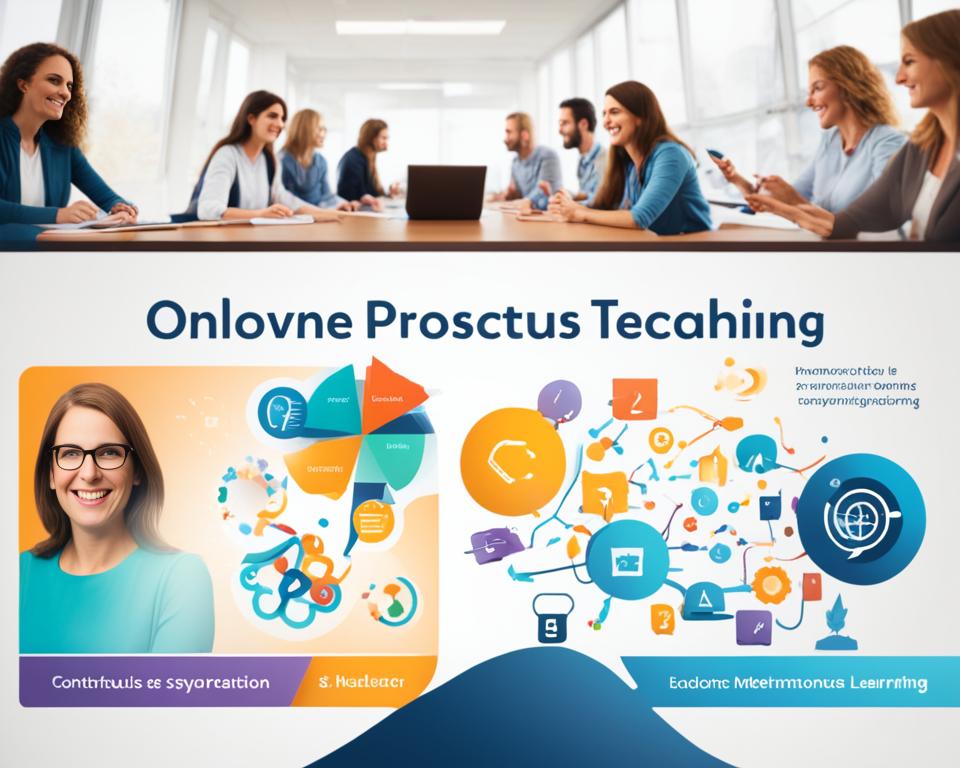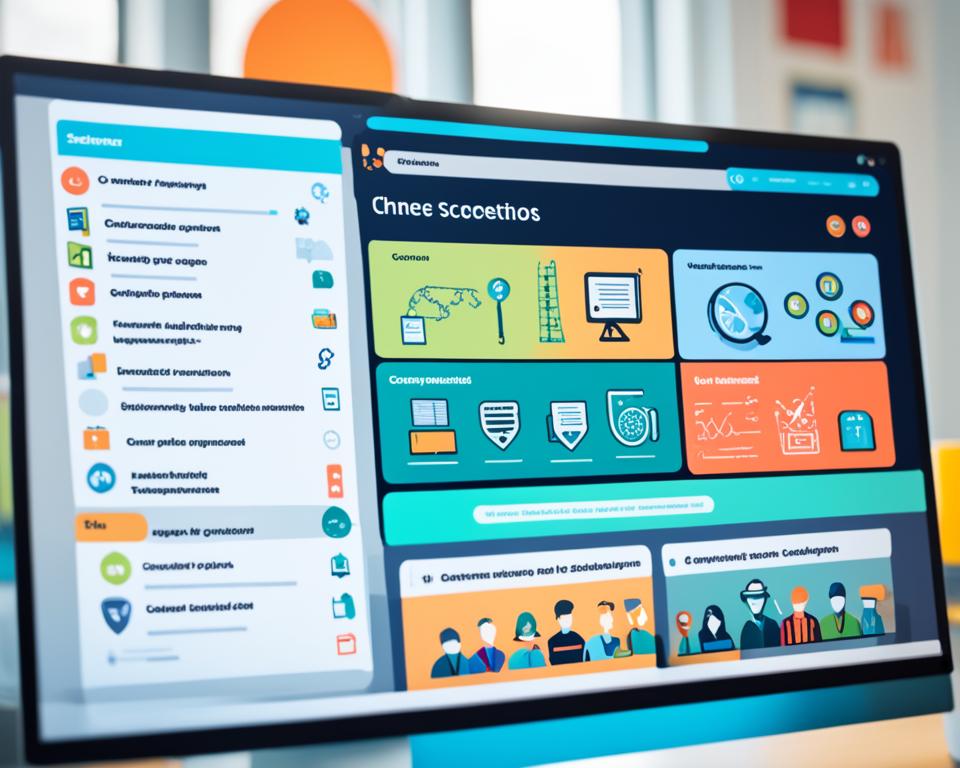As online education continues to gain popularity, schools and institutions face the challenge of maintaining the same level of quality in their online programs as in traditional classrooms. Ensuring online education excellence requires careful evaluation and quality assurance measures to provide students with a valuable and effective learning experience.
In this section, we will explore the strategies and practices that schools and institutions can implement to ensure the quality of their online education programs. From program evaluation to faculty training, each aspect plays a crucial role in creating a successful online learning environment for students.
Key Takeaways:
- Evaluating online programs is vital for ensuring their quality.
- Faculty training and professional development contribute to effective online instruction.
- Engaging students through interactive activities enhances the online learning experience.
- Creating partnerships with community-based organizations can provide additional support and resources.
- Establishing quality assurance measures leads to online education excellence.
Challenges in online education instruction
Online education presents unique challenges for instructors, requiring them to navigate a different teaching environment and establish effective communication and interaction with their students. These challenges can impact the quality of online learning and require innovative solutions to ensure a seamless educational experience.
One of the primary challenges in online education is the role of instructors. While traditional classroom teaching relies heavily on face-to-face interactions, online instructors must adapt their teaching methods to a virtual setting. This transition requires a comprehensive understanding of online learning platforms and instructional tools to effectively engage students.
Effective communication plays a crucial role in overcoming the challenges of online education. In an online course, instructors must work diligently to establish clear and concise communication channels with their students. Prompt response to queries, regular updates, and encouraging feedback are essential for fostering a supportive and engaging learning environment.
Furthermore, online instructors must also find ways to facilitate effective interaction and collaboration among students. This can be challenging as the traditional in-person dynamics are replaced by virtual discussions and peer-to-peer engagement. However, leveraging technology tools, such as discussion forums, video conferencing, and collaborative platforms, can promote active participation and create a sense of community in online courses.
In the context of online education, effective communication is not just about transmitting information—it serves as the foundation for building connections, fostering engagement, and supporting student success.
The Role of Instructors in Online Learning
The role of instructors in online learning goes beyond just delivering content. They serve as facilitators, guides, and mentors, providing students with guidance, support, and personalized feedback. Instructors must create a structured and inclusive learning environment that promotes active learning and critical thinking.
Table: Challenges Faced by Online Instructors
| Challenges | Solutions |
|---|---|
| Lack of face-to-face interaction | Utilize video conferencing tools for live discussions and virtual office hours. |
| Building rapport and creating a sense of community | Encourage collaboration through group projects and interactive activities. |
| Managing student engagement | Implement diverse instructional strategies, such as multimedia presentations and interactive quizzes. |
| Overcoming technical difficulties | Provide technical support resources and clear instructions for accessing course materials and assignments. |
By recognizing the unique challenges faced by online instructors and proactively addressing them, educational institutions can ensure the delivery of high-quality online courses that meet the needs of their students.
Quality control in online education
Ensuring quality in online education is paramount to maintaining high standards and meeting the diverse needs of students. It requires a comprehensive approach that encompasses various aspects, including online course standards, online education accreditation, and evidence of effective instructional techniques.
The development of online course standards plays a crucial role in quality assurance. These standards provide a framework for designing and delivering online courses that meet rigorous academic criteria. By adhering to established standards, schools and institutions can ensure consistency and quality across their online education programs.
Accreditation associations play a significant role in setting and maintaining these online course standards. These organizations evaluate online learning programs and ensure that they meet the required benchmarks in terms of curriculum, faculty qualifications, student support services, and learning outcomes. Online education accreditation provides credibility and reassurance to students, employers, and the broader education community.
It is important for faculty members in online education to be well-trained and equipped with the necessary skills to deliver effective instruction. Faculty training should include a focus on online pedagogy, effective use of instructional technologies, and strategies for fostering student engagement in online learning environments. When faculty members are properly trained, they are better prepared to facilitate meaningful interactions, provide timely feedback, and create a supportive online learning community.
| Enhanced Learning Experience | Increased Student Success | Improved Institutional Reputation |
|---|---|---|
| Consistent instructional quality | Higher graduation rates | Positive word-of-mouth |
| Engaging and interactive learning activities | Improved student retention | Attracting new students |
| Timely feedback and support | Positive student outcomes | Building strong partnerships |
By implementing quality control measures in online education, schools can ensure that students receive a high-quality learning experience. This, in turn, can lead to increased student success, improved institutional reputation, and a positive impact on the larger education community.
Student and faculty concerns
Many students and faculty members have valid concerns about the quality of online education. These concerns revolve around several key areas:
- Concerns about online education quality: Students often worry about the overall quality of online courses and whether they will receive the same level of education as in traditional in-person classes. Faculty members, on the other hand, may question the effectiveness of online instruction and its impact on student learning outcomes.
- Information transparency in online courses: Students may find it challenging to gather essential information about online courses, such as syllabi, course materials, and prerequisites for enrollment. This lack of transparency can hinder students’ ability to make informed decisions about their education.
- Faculty training for online teaching: Many faculty members lack specific training in online teaching methodologies and may feel ill-prepared to effectively facilitate online courses. This lack of training can impact the quality of instruction and the overall learning experience for students.
This section will address these concerns and offer actionable recommendations for improving the quality of online education. By addressing these concerns head-on, schools and institutions can enhance the overall online learning experience for students and equip faculty members with the necessary tools and skills to facilitate effective online instruction.
“It is crucial for schools and institutions to prioritize addressing the concerns of both students and faculty members to ensure a high-quality online education experience.”
To better understand these concerns, let’s take a closer look at the different perspectives:
Student Concerns
Students who opt for online education may have reservations about the quality of instruction and the overall educational experience. Some common concerns include:
- Course quality: Students want to ensure that the online courses they enroll in meet the same academic standards as traditional in-person classes.
- Interaction and engagement: Students may worry about the lack of face-to-face interactions with instructors and classmates, and how it may affect their ability to engage and participate actively in the learning process.
- Technical support: Access to reliable technical support is crucial for students who may encounter technology-related difficulties during their online courses. Students want to feel confident that they will receive prompt assistance when needed.
- Credential recognition: Students may be concerned about how online degrees or certifications will be recognized by future employers or academic institutions.
Addressing these concerns requires schools to provide clear information about the quality and credibility of their online courses, as well as robust support systems to ensure a positive learning experience.
Faculty Concerns
Faculty members responsible for online instruction may face their own set of concerns when transitioning to online teaching. These concerns may include:
- Lack of training: Faculty members who are new to online teaching may feel uncertain about how to effectively deliver course content, engage students, and facilitate meaningful discussions in the virtual classroom.
- Workload management: Balancing online teaching responsibilities with other academic activities, such as research or administrative duties, can be challenging for faculty members.
- Student assessment: Assessing and providing feedback on student work in an online environment may present unique challenges that faculty members need guidance on.
- Changes in teaching methods: Faculty members accustomed to traditional classroom settings may feel resistant or overwhelmed by the need to adapt their teaching methods to the online environment.
To address these concerns, institutions need to prioritize faculty training and provide ongoing support to ensure that instructors are equipped with the necessary skills and resources to deliver high-quality online instruction.
Recommendations for Improving Online Education Quality
In order to address the concerns of both students and faculty members and enhance the quality of online education, schools and institutions should consider implementing the following recommendations:
| Recommendation | Description |
|---|---|
| Enhance information transparency | Provide comprehensive and readily-accessible information about online courses, including clear syllabi, course objectives, prerequisites, and expectations. |
| Invest in faculty training | Offer professional development opportunities and training programs to equip faculty members with the necessary skills to effectively teach online courses. |
| Facilitate student-faculty communication | Establish channels for students to communicate with faculty members, such as discussion forums, virtual office hours, and timely email responses. |
| Implement quality assurance measures | Develop a process for regularly evaluating online courses to ensure they meet academic standards and incorporate student feedback for continuous improvement. |
| Create a supportive learning environment | Provide technical support, online resources, and peer-to-peer networking opportunities to help students navigate the online learning experience. |
By addressing the concerns of both students and faculty members and implementing these recommendations, institutions can enhance the quality and effectiveness of online education, ensuring a positive learning experience for all stakeholders.
Advantages of online distance learning
Online education has revolutionized the way students learn, offering numerous advantages that traditional classroom settings may not provide. In this section, we will explore the practical benefits of online education, discussing the flexibility in scheduling, cost savings, and accessibility that online distance learning offers.
Flexibility in Scheduling
One of the greatest advantages of online education is the flexibility it provides in scheduling. With online courses, students have the freedom to create their own study schedules and learn at their own pace, making it ideal for individuals with other commitments such as work or family responsibilities. Students can access course materials and lectures at any time, allowing them to balance their education with other aspects of their lives.
Cost Savings
Online courses often come with cost savings for students and educational institutions alike. Without the need for physical classrooms and equipment, online education eliminates expenses associated with campus maintenance and utilities. As a result, educational institutions can offer online courses at a lower cost, making education more accessible to a wider range of students. Additionally, students can save money on commuting, housing, and textbooks, as online materials are often included in the course fees.
Instant Updates of Learning Materials
In traditional education settings, printed materials can quickly become outdated. Online education, on the other hand, allows for instant updates of learning materials. This means that students always have access to the most up-to-date information and resources, ensuring that they receive a current and relevant education. Whether it’s a new textbook edition or the latest research findings, online education keeps students informed and engaged in their field of study.
Online education offers flexibility in scheduling, cost savings, and instant updates of learning materials, making it a practical choice for those seeking high-quality education at their own pace.
With these advantages, it’s no wonder that online distance learning has gained popularity among students and educational institutions. The flexibility in scheduling, cost savings, and accessibility of online education make it an attractive option for individuals looking to further their education or enhance their career prospects.

Disadvantages of online distance learning
While online distance learning offers numerous advantages, it is important to acknowledge and address the potential disadvantages associated with this mode of education. This section will explore some of the challenges and drawbacks that students may encounter when pursuing education online.
Potential Distractions in Online Learning
One of the primary concerns of online education is the presence of distractions that can hinder a student’s focus and productivity. Without the physical presence of a teacher or classmates, it becomes crucial for students to create a dedicated and distraction-free learning environment. However, the allure of social media, notifications from various apps, and other online temptations can divert attention away from coursework.
Managing distractions requires discipline and self-motivation. It’s important for students to set clear boundaries, establish a schedule, and utilize productivity tools to minimize distractions and optimize their learning experience.
Hidden Costs of Online Courses
Another potential disadvantage of online education is the presence of hidden costs that may not be immediately apparent to students. While online courses are often perceived as more affordable than traditional in-person classes, additional expenses can arise. These may include costs associated with reliable internet connectivity, computer hardware and software requirements, online textbooks or resources, and subscription fees for certain course materials or platforms.
To avoid unexpected financial burden, it’s crucial for students to carefully review the requirements and associated expenses before enrolling in an online course. This will ensure they are well-prepared financially and can fully commit to their educational journey without any financial setbacks.
Challenges of Managing Screen Time
Online education heavily relies on digital devices, which can pose challenges in managing screen time. Prolonged exposure to screens can lead to eye strain, fatigue, and other physical discomforts. Additionally, spending excessive time in front of a screen can take a toll on mental health and contribute to feelings of isolation and detachment.
To mitigate the negative effects of extensive screen time, it is important for students to prioritize self-care and take regular breaks. Engaging in physical activities, practicing mindfulness, and maintaining a healthy work-life balance are essential components of managing screen time effectively.
Sense of Isolation in Online Classes
One common concern among online learners is the potential for a sense of isolation and reduced social interaction. Unlike traditional classroom settings, online education lacks face-to-face interactions and immediate feedback from peers and instructors. This can lead to feelings of loneliness and disengagement.
To overcome the sense of isolation, students can actively participate in virtual discussions, join study groups, and leverage online platforms to connect with classmates and instructors. Building a strong online community can help foster collaboration, support, and a sense of belonging, ultimately enhancing the overall learning experience.
Although online distance learning comes with its own set of disadvantages, being aware of these challenges and implementing strategies to overcome them can help students navigate through their educational journey successfully.
Strategies for student engagement in online learning
To ensure the quality of online education, it is important to engage students in the learning process. By implementing effective strategies for student engagement in online courses, educators can enhance the overall learning experience and promote academic success. This section will discuss various approaches that can be used to promote student engagement in online learning, including interactive online learning activities and peer collaboration in virtual classrooms.
Promoting Interactive Online Learning Activities
Interactive online learning activities are essential for fostering student engagement and active participation in the virtual classroom. These activities encourage students to think critically, apply concepts, and collaborate with their peers. Here are some effective strategies for promoting interactive online learning activities:
- Virtual simulations and experiments: Incorporate virtual simulations and experiments into the curriculum to provide students with opportunities to apply theoretical knowledge in a practical setting.
- Discussion forums and chat rooms: Create discussion forums and chat rooms where students can engage in meaningful discussions, share ideas, and ask questions.
- Group projects and presentations: Assign group projects and presentations that require students to collaborate with their peers, fostering teamwork and communication skills.
- Interactive quizzes and games: Design interactive quizzes and educational games to make the learning experience fun and engaging.
Promoting Peer Collaboration in Virtual Classrooms
Peer collaboration is a valuable aspect of the learning process that promotes active learning, critical thinking, and communication skills. In online learning environments, facilitating peer collaboration requires intentional strategies to ensure students can effectively work together. Here are some effective approaches for promoting peer collaboration in virtual classrooms:
- Virtual breakout rooms: Utilize virtual breakout rooms to facilitate small group discussions and collaborative activities, allowing students to work closely with their peers.
- Peer feedback and review: Establish opportunities for students to provide constructive feedback and review each other’s work, promoting deeper understanding and growth.
- Collaborative projects and assignments: Assign collaborative projects and assignments that require students to work together to solve problems or complete tasks.
- Online study groups: Encourage students to form online study groups where they can discuss course materials, exchange ideas, and support each other academically.
The combination of interactive online learning activities and peer collaboration in virtual classrooms creates a dynamic learning environment that promotes student engagement and enhances learning outcomes. By implementing these strategies, educators can empower students to take an active role in their education and maximize their potential in online courses.

| Benefits of Student Engagement in Online Learning | Strategies for Student Engagement |
|---|---|
| 1. Improved academic performance | 1. Incorporate interactive online learning activities |
| 2. Enhanced critical thinking skills | 2. Facilitate peer collaboration in virtual classrooms |
| 3. Increased motivation and active participation | 3. Utilize virtual breakout rooms for small group discussions |
| 4. Strengthened communication and teamwork skills | 4. Encourage online study groups for collaborative learning |
Supporting students with limited tech access
Online learning has become an essential tool for education, allowing students to continue their studies even when physical classrooms are not available. However, it is important to acknowledge that not all students have access to reliable internet connections or the necessary technology at home. To ensure equitable learning opportunities for all students, educators must implement strategies to support those with limited tech access.
Providing offline learning materials
One effective approach is to provide offline learning materials that students can access without an internet connection. These materials can include textbooks, workbooks, printed assignments, and supplementary reading materials. By offering offline resources, educators enable students to continue learning even when they cannot connect online. Additionally, offline materials allow students to work at their own pace, review content as needed, and engage in self-directed learning.
Implementing effective communication strategies
Communication plays a crucial role in supporting students with limited tech access. Educators should establish alternative channels of communication to ensure that these students can stay connected and receive necessary guidance. This can include phone calls, text messages, or even mailing assignments and feedback. Clear communication channels help students feel supported and allow them to address any challenges they may face during their offline learning journey.
“By offering offline resources, educators enable students to continue learning even when they cannot connect online.”
Collaborating with community organizations
Engaging with local community organizations can also be a valuable strategy for supporting students with limited tech access. These organizations may have resources available, such as public libraries or community centers, where students can access computers and reliable internet connections. By partnering with community organizations, educators can help bridge the digital divide and ensure that every student has equal access to online learning opportunities.
Balancing synchronous and asynchronous learning
Online courses offer the flexibility of delivering instruction synchronously or asynchronously. Synchronous learning refers to real-time interactions between students and instructors, while asynchronous learning involves recorded presentations and activities that students can access at their own pace. Both approaches have their unique benefits, and finding a balance between the two can enhance the online learning experience.
The Benefits of Synchronous Learning
Synchronous learning provides students with the opportunity for immediate interaction and discussion with their instructors and peers. This fosters a sense of community and collaboration, similar to traditional face-to-face classrooms. Students can ask questions, seek clarifications, and engage in lively discussions, promoting active learning and critical thinking. Additionally, synchronous sessions allow instructors to provide immediate feedback and address student concerns in real-time, leading to a more dynamic and engaging learning experience.
The Advantages of Asynchronous Learning
Asynchronous learning offers flexibility and convenience to students who may have other commitments or time zone differences. With recorded lectures and materials, students can access the content at their preferred time and pace, allowing them to adapt their learning to their individual needs and schedules. Asynchronous learning also enables students to review complex concepts, pause and rewind lectures, and revisit course materials, promoting self-paced and personalized learning experiences.
The combination of synchronous and asynchronous learning can provide a well-rounded online course experience that leverages the benefits of both approaches. By integrating recorded lectures and materials with live discussions and interactive activities, instructors can offer flexibility in course delivery while still fostering meaningful engagement and collaboration.
Tips for Balancing Synchronous and Asynchronous Learning
- Use synchronous sessions for live lectures, discussions, and interactive activities that require immediate feedback and real-time interaction.
- Record and provide access to these synchronous sessions for students who cannot attend in real-time.
- Utilize asynchronous elements such as pre-recorded lectures, online reading materials, and self-paced assignments to accommodate different learning preferences and time constraints.
- Design synchronous and asynchronous components to complement each other, ensuring a coherent and integrated learning experience.
- Encourage active participation in both synchronous and asynchronous activities through discussion boards, online forums, and collaborative projects.
- Ensure clear communication and expectations regarding the timing of synchronous sessions and due dates for asynchronous assignments.
By balancing synchronous and asynchronous learning in online courses, educators can provide students with the flexibility to engage with course materials and participate in interactive activities while fostering a strong sense of community and collaboration. This blended approach allows for personalized learning experiences and accommodates diverse student needs, ultimately enhancing the overall quality of online education.

Comparing Synchronous and Asynchronous Learning
| Synchronous Learning | Asynchronous Learning |
|---|---|
| Real-time interaction | Flexibility in scheduling |
| Immediate feedback | Self-paced learning |
| Promotes active engagement | Allows for review and reflection |
| Enhances sense of community | Accommodates different time zones |
Ensuring teacher training for online instruction
To ensure the quality of online instruction, it is crucial to provide teachers with the necessary training and professional development opportunities. Online teaching requires a unique set of skills and knowledge that may differ from traditional classroom instruction. Teachers need to understand the nuances of online pedagogy, effective use of technology, and strategies for engaging students in virtual learning environments. Additionally, they should be equipped with the tools and resources to address the challenges specific to online education.
Professional development programs for online instructors should focus on enhancing their instructional practices, promoting effective communication and collaboration, and incorporating interactive elements into their online courses. These programs can be delivered through various formats, including webinars, workshops, and online courses, allowing teachers to learn at their own pace and convenience.
By investing in teacher training for online instruction, schools and institutions can empower educators to deliver high-quality online education experiences. Well-trained instructors are better equipped to navigate the unique challenges of online teaching, create engaging and interactive learning environments, and provide personalized support to students.
Recommendations for Implementing Effective Online Pedagogy:
- Offer comprehensive training programs that cover both the technical aspects of online teaching and the pedagogical strategies required for effective instruction in a virtual setting.
- Encourage collaboration among online instructors through virtual communities of practice, where they can share best practices, exchange ideas, and seek support from their peers.
- Provide ongoing support and mentoring to online instructors, giving them opportunities to reflect on their teaching practices and receive constructive feedback.
- Incorporate hands-on activities and simulations in teacher training programs to allow instructors to practice and apply their newly acquired skills in a safe and supportive environment.
- Stay up-to-date with the latest research and best practices in online pedagogy, ensuring that training programs align with current trends and advancements in the field.
| Benefits of Teacher Training for Online Instruction | Challenges Addressed |
|---|---|
| 1. Enhanced Instructional Practices | 1. Adapting to the virtual learning environment |
| 2. Engaging and Interactive Learning Environments | 2. Promoting student engagement in online courses |
| 3. Personalized Support to Students | 3. Addressing individual learning needs in virtual settings |
| 4. Effective Communication and Collaboration | 4. Establishing meaningful connections with students |
| 5. Technology Integration | 5. Leveraging technology for effective online instruction |
Partnering with community-based organizations
In online education, community-based organizations form a crucial support system for students, teachers, and the wider community. Collaborating with these organizations can foster a sense of belonging, enhance access to resources, and promote engagement in online learning environments. By building strong relationships with community organizations, educational institutions can create a more inclusive and supportive online education experience.
One of the key benefits of partnering with community organizations in online education is the opportunity for community partnerships. Through these partnerships, schools and institutions can tap into the expertise and resources offered by community organizations to complement their online programs. For example, a local library may provide access to e-books or other digital resources for students, while a nonprofit organization can offer tutoring or mentoring services. These partnerships can help fill gaps in resources and support, ensuring that students have the tools they need to succeed in their online courses.
Moreover, community organizations can also play a vital role in providing support to students and teachers. For instance, they can offer guidance on navigating online platforms, technical troubleshooting, or assistance with accessing the internet for students with limited connectivity. By collaborating with community organizations, educational institutions can leverage their expertise and networks to provide timely and valuable support services to the online learning community.
Building relationships in online learning is especially important to create a sense of connection and belonging. Connection with peers, instructors, and the community enhances engagement, retention, and overall satisfaction with the online learning experience. Community organizations can facilitate connection and collaboration by organizing virtual events, online clubs, and forums where students can interact with each other and with members of the wider community.
Consider the following examples of community partnerships in online education:
| Community Organization | Partnership Activities |
|---|---|
| Local Library | – Providing access to digital resources – Organizing virtual book clubs or reading contests – Offering research assistance |
| Nonprofit Organization | – Providing tutoring or mentoring services – Offering scholarships or grants – Facilitating career development opportunities |
| Community Center | – Organizing virtual events or workshops – Establishing online clubs or interest groups – Providing wellness and mental health support |
By fostering partnerships with community-based organizations, schools and institutions can enhance the quality of their online education programs, promote student success, and create a more connected and supportive online learning community.
Conclusion
Ensuring the quality of online education is crucial in maintaining high standards and providing effective learning experiences for students. This article has explored various strategies for ensuring quality in online learning programs.
Firstly, strategic planning plays a key role in maintaining online education standards. Schools and institutions need to develop clear goals and objectives for their online programs, aligning them with the needs and expectations of students. A well-designed curriculum, supported by appropriate resources and learning materials, is essential for ensuring quality in online education.
Secondly, faculty training is vital for online instruction. Online instructors should receive comprehensive training in online pedagogy, instructional design, and the use of digital tools and technologies. Ongoing professional development opportunities can help instructors stay updated with the latest trends and best practices in online teaching, ensuring that they can deliver engaging and effective instruction in the virtual classroom.
Lastly, student engagement and community partnerships are key strategies for maintaining quality in online education. Engaging students through interactive activities, peer collaboration, and personalized support can enhance their learning experiences and outcomes. Building partnerships with community-based organizations can provide additional resources and support for students, fostering a sense of belonging and connection in the online learning environment.
FAQ
How can schools and institutions ensure the quality of their online education programs?
Schools can ensure the quality of their online education programs through a variety of methods, including program evaluation, regular assessment of online teaching effectiveness, and maintaining online course quality standards. Accreditation associations also play a crucial role in setting and maintaining standards for online courses.
What are the challenges faced by online instructors in delivering effective instruction?
Online instructors face challenges such as adapting to a different teaching environment, establishing effective communication and interaction with students, and addressing the concerns and barriers faced by students in online courses.
How can administrators ensure quality control in online education?
Administrators can ensure quality control in online education by implementing rigorous evaluation processes, monitoring the quality of online course materials and pedagogy, and providing faculty with training and professional development opportunities in online teaching.
What concerns do students and faculty have about the quality of online education?
Students may have concerns about finding information about the quality of online courses and the prerequisites for enrollment. Faculty may be concerned about their lack of training in online teaching and the challenges of balancing their teaching responsibilities with other academic activities.
What are the advantages of online distance learning?
Online distance learning offers advantages such as flexibility in scheduling, cost savings for students and schools, improved accessibility, and instant updates of learning materials.
What are the disadvantages of online distance learning?
Disadvantages of online distance learning include potential distractions, hidden costs of online courses, challenges of managing screen time, and the sense of isolation that students may experience in online classes.
How can student engagement be promoted in online courses?
Student engagement in online courses can be promoted through the use of interactive learning activities, peer collaboration in virtual classrooms, and other strategies that encourage active participation and interaction.
How can schools support students with limited tech access in online learning?
Schools can support students with limited tech access by providing offline learning materials, implementing effective communication strategies, and exploring alternative delivery methods that do not rely heavily on internet access.
How can a balance between synchronous and asynchronous learning be achieved in online courses?
A balance between synchronous and asynchronous learning can be achieved by combining live interactions between students and instructors with recorded presentations and activities. This allows for flexibility in scheduling while still providing opportunities for real-time engagement.
How can teacher training for online instruction be ensured?
Teacher training for online instruction can be ensured through the provision of professional development opportunities, specific training in online pedagogy, and ongoing support and mentorship for online instructors.
How can community-based organizations contribute to online education?
Community-based organizations can contribute to online education by providing support to students, fostering relationships between students, teachers, and the community, and offering resources and expertise that enhance the online learning experience.
What are the key strategies for maintaining high standards in online education programs?
Key strategies for maintaining high standards in online education programs include strategic planning, faculty training, student engagement, quality control measures, and partnerships with community organizations. These strategies work together to ensure the quality and effectiveness of online learning.





